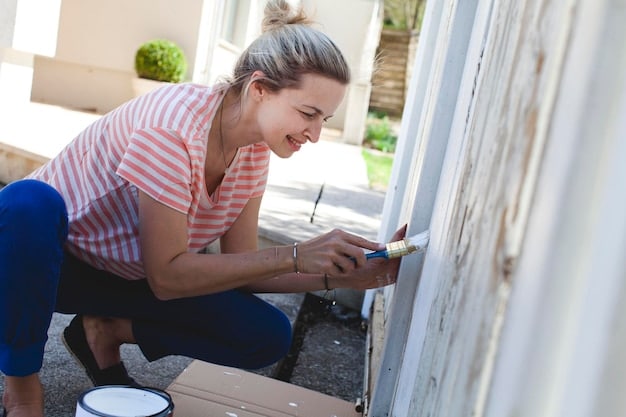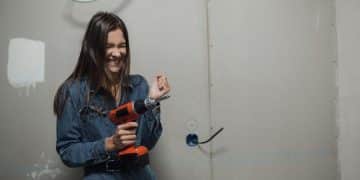DIY Home Energy Audit: Slash Bills by 15% in 3 Months

Performing a DIY home energy audit is a practical and effective strategy for homeowners in the US to pinpoint energy waste, implement targeted improvements, and significantly reduce utility bills by up to 15% within a three-month timeframe by identifying opportunities for enhanced energy efficiency.
Are you tired of skyrocketing utility bills eating into your budget? The good news is you don’t need a professional to pinpoint many of the culprits behind your home’s energy drain. A DIY home energy audit: slash your utility bills by 15% in 3 months guide can empower you to take control, identify inefficiencies, and start saving money right away.
Understanding Your Energy Consumption
Before you can begin to save, understanding where your energy goes is the crucial first step. Many homeowners are surprised to learn how much of their electricity, gas, or oil consumption isn’t actually going towards optimal comfort, but rather escaping through unnoticed leaks and inefficient systems. A systematic approach to auditing your home’s energy use can reveal these hidden losses and guide your efforts towards meaningful savings.
Your utility bills are more than just a cost; they’re a diagnostic tool. Take some time to review your bills from the past 12 months. Look for patterns, sudden increases, and note which months have the highest consumption. This historical data can offer clues about seasonal energy drains, such as higher heating costs in winter or increased air conditioning use in summer.
Decoding your utility statements
Dive deep into the details of your energy statements. Many utility providers break down consumption by category, such as heating, cooling, and general electricity use. Understanding these breakdowns can highlight areas where your home is least efficient.
- Kilowatt-hours (kWh) for electricity: This measures electrical energy consumed. Higher kWh means more electricity used.
- Therms or CCF for natural gas: These units measure natural gas consumption, primarily used for heating, water heating, and some appliances.
- Gallons for oil or propane: If your home uses these fuels, track consumption to understand heating patterns.
Beyond the numbers, think about your daily habits. Are lights left on in empty rooms? Do appliances run on standby? Small adjustments to behavior can complement your audit and amplify savings. By combining bill analysis with a conscious awareness of daily energy habits, you create a solid foundation for identifying energy-saving opportunities.
It’s also beneficial to compare your usage with similar homes in your area, if your utility provides such data. While not perfectly accurate, it can give you a general idea of whether your energy consumption is exceptionally high or within an expected range. This initial assessment helps in setting realistic goals for your energy-saving journey, aiming for that 15% reduction in less than three months.
The Essential Tools for Your DIY Audit
Embarking on a comprehensive DIY energy audit doesn’t require specialized, costly equipment. Many of the tools you’ll need are likely already in your home or can be acquired affordably. The goal is to systematically inspect your home for vulnerabilities where energy is escaping or being misused.
Gathering the right tools before you start will streamline the process and ensure you don’t miss critical areas. Think like a detective, equipped with the right gear to uncover hidden clues that point to energy waste.
Simple, effective tools for detection
Your DIY toolkit can be quite basic but highly effective. A few key items can help identify drafts, measure temperatures, and inspect hard-to-reach areas.
- Flashlight: Essential for peering into dark corners, attics, crawl spaces, and behind appliances.
- Incense stick or smoke pen: These are invaluable for detecting air leaks. The wavering smoke indicates drafts around windows, doors, and outlets.
- Infrared thermometer (optional but helpful): This tool can show surface temperature differences, revealing insulation gaps or drafty areas more precisely.
- Caulk gun and caulk: For sealing small cracks and gaps uncovered during the audit.
- Weatherstripping: To seal around doors and windows.
- Pen and paper (or a digital device): To meticulously record your findings and plan your actions.
Beyond these physical tools, perhaps the most important asset is your observational skill and a methodical approach. Walk through your home actively looking for clues, not just casually observing. Pay attention to how different rooms feel: are some consistently colder or warmer than others? These subtle cues often point to larger issues.
Don’t underestimate the power of your hands. Simply feeling for drafts around outlets, windows, and light fixtures can provide immediate feedback. An organized approach, room by room, will ensure that no potential energy-wasting area is overlooked, setting you up for success in your goal to significantly reduce utility bills.
Step-by-Step Audit: Identifying Energy Leaks
The core of any effective energy audit lies in systematically identifying where your conditioned air is escaping or where unconditioned air is entering. These “energy leaks” are often subtle and can accumulate to significant losses, driving up your utility bills. This step requires a keen eye and a patient approach.
Start by breaking your home into zones: exterior, interior envelope, and specific systems. This compartmentalized approach ensures that every potential area of energy loss is thoroughly inspected.
Exterior check: the first line of defense
Begin your audit from the outside in. Inspect the exterior of your home for obvious cracks or gaps in the siding, around pipes, and where different building materials meet. These can be direct entry points for cold air in winter and hot air in summer.
- Foundation and landscaping: Check for cracks in the foundation where air might seep in. Also, observe if shrubs or trees block airflow around your AC unit, reducing its efficiency.
- Roof and attic vents: Look for damaged shingles or flashing. Ensure attic vents are clear but properly sealed to prevent heat loss/gain while allowing adequate ventilation.
- Doors and windows: Visually inspect these for obvious gaps or damaged seals. Close all windows and doors tightly and then feel for drafts, especially on windy days.
Move inside to focus on your home’s envelope. This includes walls, ceilings, and floors. Use your incense stick or smoke pen to delicately move around window and door frames, electrical outlets, light switches, and any penetrations for plumbing or wiring. Watch for the smoke to waver, indicating an air leak. Don’t forget recessed lighting fixtures, attic hatches, and fireplace dampers.
Basements and crawl spaces are often overlooked but can be major sources of energy loss. Check for moisture issues, gaps in rim joists, and uninsulated pipes or ducts. Sealing these areas can have a surprisingly large impact on your overall energy efficiency. Document every find, no matter how small, as each one contributes to the overall picture of your home’s energy consumption.

Appliances and Lighting: Unseen Energy Hogs
After addressing air leaks, the next frontier in your DIY energy audit involves scrutinizing your home’s appliances and lighting. While drafts are often the culprits for heating and cooling losses, inefficient appliances and outdated lighting can quietly consume significant amounts of electricity, adding substantial amounts to your monthly utility statement.
This phase of the audit focuses on the operational efficiency of the devices that power your daily life, from your refrigerator to your light bulbs. Evaluating these items can uncover opportunities for substantial savings with minimal effort.
Assessing appliance efficiency
Appliances are not created equal in terms of energy consumption. Older models, in particular, often lack the energy-saving technologies of their modern counterparts. Begin by identifying the age and energy rating of your major appliances.
- Refrigerator and freezer: Check the coils for dust accumulation and ensure door seals are tight. A simple paper test (close the door on a piece of paper; if it slides out easily, the seal might be weak) can help.
- Washing machine and dryer: Are you using cold water for laundry when possible? Do you clean the lint trap regularly? These small habits impact energy use.
- Dishwasher: Maximize each load and use air-dry settings if available.
- Water heater: Check its temperature setting. Most homes do not need it above 120°F (49°C). Consider insulating an older tank.
- Electronics: Many electronics consume power even when turned off (phantom load or vampire draw). Unplug chargers and devices not in use, or use smart power strips.
Beyond major appliances, consider the cumulative effect of smaller electronics. Phone chargers, coffee makers, and even your TV can draw power around the clock. Investing in smart power strips that cut power to devices not actively in use can prevent this “vampire drain” and result in noticeable savings over time.
For lighting, the transition from incandescent bulbs to LED (Light Emitting Diode) technology is one of the quickest and most impactful ways to reduce electricity consumption. LEDs use significantly less energy and last much longer, resulting in considerable long-term savings. Replace bulbs strategically, starting with the most frequently used lights in your home.
Optimizing Heating and Cooling Systems
Your heating, ventilation, and air conditioning (HVAC) systems are often the largest energy consumers in your home, representing a significant portion of your utility bills. Optimizing these systems is therefore paramount for achieving that 15% reduction goal within three months.
This section of your DIY audit will delve into evaluating the efficiency of your furnace, air conditioner, and ductwork, alongside the critical role of insulation and thermostats.
HVAC maintenance and operational efficiency
Regular maintenance performed by you or a professional can dramatically improve your HVAC system’s efficiency. Simple tasks can yield surprising results.
- Change air filters regularly: A dirty filter restricts airflow and makes your system work harder, consuming more energy. Check monthly and replace every 1-3 months.
- Clear around outdoor units: Ensure your outdoor AC unit or heat pump is free of debris, leaves, and overgrown vegetation. This allows for proper airflow and efficient operation.
- Inspect ductwork: Look for visible leaks in your duct system, especially in attics, crawl spaces, and basements. These leaks can waste a substantial amount of conditioned air. Use mastic sealant or specialized aluminum tape (not duct tape!) to seal any gaps.
Insulation plays a crucial role in maintaining comfortable indoor temperatures and reducing the load on your HVAC system. Check the insulation levels in your attic, walls, and floors. For attics, aim for at least R-38 in most climates (check local building codes for specific recommendations). If your insulation is old, compressed, or insufficient, adding more can significantly reduce heat transfer.
Finally, your thermostat is the brain of your HVAC system. Consider upgrading to a programmable or smart thermostat. These devices allow you to set schedules for heating and cooling based on your daily routine, or even learn your preferences and adjust automatically. Setting back your thermostat by 7-10 degrees for 8 hours a day (when you’re away or asleep) can save up to 10% on heating and cooling costs.
By diligently focusing on these aspects, from regular maintenance to smart thermostat usage and proper insulation, you directly impact your home’s largest energy consumers. These efforts collectively feed into the larger objective of slashing your utility bills by 15% in a relatively short period.

Implementing Improvements and Tracking Progress
Once you’ve completed your DIY energy audit and identified the key areas for improvement, the next crucial phase is implementation. This is where observation transforms into action, and potential savings become a reality. Prioritizing your tasks and making systematic changes are vital for achieving your 15% reduction target within three months.
Think of it as a rolling project: tackle the easiest and most impactful changes first, then move on to more involved tasks. This approach builds momentum and allows you to see early results, motivating further efforts.
Prioritizing and executing improvements
Not all energy-saving measures are equally effective or easy to implement. Focus on a “low-hanging fruit” approach initially. These are actions that cost little or nothing and can be done quickly, yet offer significant returns.
- Seal drafts: This is often the most cost-effective improvement. Use caulk for small cracks and gaps, and weatherstripping for doors and windows. Foam gaskets for electrical outlets and light switches are also very effective.
- Adjust thermostat settings: Implement a programmable or smart thermostat schedule. Lowering heat in winter and raising AC in summer when you’re not home or asleep provides instant savings.
- Switch to LED lighting: Replace incandescent bulbs, especially in frequently used fixtures.
- Appliance maintenance: Clean refrigerator coils, dryer lint traps, and ensure efficient operation of all appliances.
After these initial quick wins, consider investments with a slightly longer payback period but higher long-term savings. This might include adding insulation to your attic, wrapping your water heater, or insulating exposed hot water pipes. Always research local rebates or incentives for energy-efficient upgrades, as these can significantly reduce your upfront costs.
Tracking your progress is just as important as implementing the changes. Continue monitoring your utility bills closely, comparing your current usage to historical data from before your audit. Look for a downward trend in consumption. Some utility companies offer online dashboards that allow you to track daily or weekly energy use, providing immediate feedback on the impact of your energy-saving efforts.
The three-month timeline is ambitious but achievable with a focused effort. By prioritizing high-impact actions, consistently implementing changes, and carefully tracking your results, you’ll not only see a reduction in your utility bills but also gain a deeper understanding of your home’s energy dynamics, fostering a more energy-conscious lifestyle.
Maintaining Energy Efficiency for Long-Term Savings
Achieving a 15% reduction in utility bills within three months through a DIY energy audit is a commendable accomplishment, but the journey towards energy efficiency doesn’t end there. Lasting savings come from integrating these practices into your regular home maintenance routine and continuously seeking new opportunities to optimize your energy consumption.
Maintaining what you’ve improved ensures that those initial savings don’t erode over time. It’s about building sustainable habits and keeping your home operating at peak energy performance year-round.
Establishing ongoing energy-saving habits
Many of the measures taken during your audit require periodic checks or minor adjustments to remain effective. Regular attention to these details will prevent energy waste from creeping back into your home.
- Seasonal checks: Perform a mini-audit at the change of seasons. Recheck weatherstripping and caulk for wear and tear, and ensure your HVAC systems are ready for the upcoming heating or cooling demands.
- Filter replacements: Stick to a schedule for replacing air filters in your HVAC system. Mark it on your calendar or set a recurring reminder.
- Appliance care: Continue to clean refrigerator coils, dryer lint traps, and ensure appliances are used efficiently. Make turning off lights and unplugging phantom loads a habit.
- Thermostat management: Ensure your programmable or smart thermostat settings are still optimized for your current schedule and preferences.
Stay informed about new energy-efficient technologies and practices. The landscape of home energy efficiency is constantly evolving, with innovations in smart home devices, insulation materials, and renewable energy options. Even small upgrades, like high-efficiency showerheads or smart plugs, can contribute to ongoing savings.
Educate everyone in your household about the importance of energy conservation. When every member is mindful of their energy use, the collective impact on your utility bills can be substantial. Simple actions, such as taking shorter showers or turning off electronics when leaving a room, can become second nature, reinforcing your overall energy-saving strategy.
By making energy efficiency a continuous effort rather than a one-time project, you ensure that the benefits of your DIY home energy audit extend far beyond the initial three months, providing long-term savings and a more comfortable, environmentally friendly home.
| Key Audit Area | Brief Description |
|---|---|
| 💨 Draft Detection | Use an incense stick to find air leaks around windows, doors, and outlets. |
| 💡 Appliance & Lighting | Upgrade to LEDs, check appliance seals, and unplug vampire loads. |
| 🌡️ HVAC Optimization | Change filters, inspect ducts, and use a programmable thermostat. |
| 💸 Bill Tracking | Regularly review utility bills to monitor savings and identify trends. |
Frequently Asked Questions About DIY Energy Audits
Sealing air leaks is consistently cited as the most effective and cost-efficient DIY energy-saving measure. Drafts around windows, doors, and electrical outlets can account for a significant portion of heat loss in winter and heat gain in summer. Simple solutions like caulk and weatherstripping offer immediate and noticeable results.
A comprehensive DIY home energy audit should be performed at least once a year, ideally before seasonal changes (e.g., fall before winter heating, spring before summer cooling). This proactive approach helps identify new issues or worn-out seals before they lead to substantial energy waste, ensuring continuous savings.
Yes, a smart thermostat can absolutely save you money. By allowing precise scheduling, remote control, and even learning your habits, it optimizes heating and cooling only when needed. Studies show that setting back your thermostat 7-10 degrees for 8 hours a day can reduce energy consumption by up to 10% annually, leading to significant savings.
Replacing very old appliances with new, Energy Star-rated models can be a worthwhile investment, especially for major energy users like refrigerators, washing machines, and water heaters. While the upfront cost is higher, the long-term energy savings, coupled with potential rebates, can lead to a quick payback period and continuous reductions in utility bills.
Phantom load, also known as “vampire draw,” refers to the electricity consumed by electronics and appliances when they are turned off but still plugged in. To reduce it, unplug chargers and devices when not in use. Using smart power strips that cut power to idle devices is another effective and convenient solution, saving energy around the clock.
Conclusion
Taking charge of your home’s energy consumption through a DIY energy audit is a powerful step towards financial savings and environmental responsibility. By systematically identifying air leaks, optimizing appliance usage, fine-tuning your HVAC system, and committing to ongoing maintenance, you can realistically aim to slash your utility bills by 15% in just three months. This journey not only puts money back in your pocket but also fosters a deeper understanding of your home’s energy dynamics, empowering you to live more efficiently and comfortably for years to come. Start today, and witness the tangible benefits of a more energy-conscious home.





